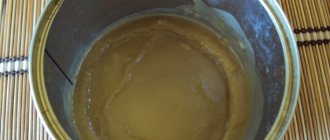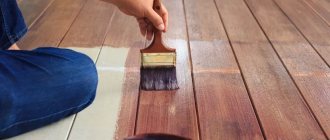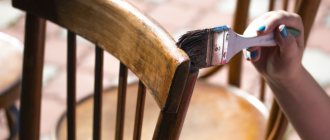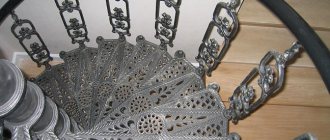Despite similar characteristics, the brushes differ significantly in their features. When applying to wood, you need to choose the right tool for applying varnish. It must be of high quality and meet all the requirements for quality work. High-quality bristles of such a tool are capable of pumping in the optimal amount of finishing composition and applying it to the wood, which significantly affects the rational use of the product.
How to choose a brush bristle for applying paint on wood
How to choose a brush for applying paint and varnish material to wood? Experts advise choosing varnish brushes with natural bristles if you want to apply varnishes and oil-based products to wood. The choice was made on such brushes, since they can hold the volume of the composition and control its application to the surface layer of the wood. When working with water-based compounds, it is better not to use such brushes; the reason for this failure was the swelling of the bristles and loss of their shape, which negatively affects the operation of the tool.
What brush should I use to apply wood varnish? It is better to choose a tool with synthetic bristles:
- nylon;
- polyamide.
Such a tool is significantly effective when working with water-soluble composition. But a natural brush has a minor drawback: its bristles fray and break more quickly, while synthetics win in this matter. And to apply the varnish, so as not to leave marks, it is recommended to work with a brush made of natural hairs, the ends of the bristles have a good split appearance. Using such a tool, you can safely varnish wood.
Advantages of varnishing and types of existing varnishes
Wood varnishing is very popular, as this type of treatment is suitable for all types of painted and unpainted wood. This type of finishing is actively carried out in the production of wooden furniture, in the manufacture of decorative products, as well as in the cladding of walls and floors in the house.
Varnish can be applied to any type of wood
There is a wide range of woodworking varnishes on the market, each of which has its own unique features and characteristics. Among the most popular compositions are:
- Oil varnishes. They contain solutions of synthetic or natural resins, due to which they create a durable yellow film on the treated surface. Most often they are used when treating walls and floors in private homes.
- Alcohol. Solutions of vegetable resins or polymers in alcohol, used for priming wooden surfaces after sanding. They are not able to provide high-quality protection for wood from moisture, but they add shine to the products and make them more durable.
- Alkyd. They are made from synthetic resins with special solvents. They are distinguished by their versatility, that is, they can be used to perform facing work in different conditions. They are used to repair facades, walls and floors in houses. They are resistant to moisture and increase the strength of processed products.
- Nitrocellulose. They are made from nitrocellulose, which is diluted in special solvents using plasticizers. Multi-layer, transparent coating of wood with nitrocellulose varnish provides the furniture with increased durability.
- Acrylic. Eco-friendly, safe varnishes based on acrylic resins. They are durable and resistant to light, but are used exclusively for interior renovation work.
- Polyurethane. They allow you to create a durable protective layer for wooden products; they are used in the manufacture of musical instruments and floor varnishing.
Regardless of the compositions used, wood must be varnished according to the manufacturer’s instructions. This is the only way to ensure the treated surface is durable, strong and protected from various external influences.
Brush shapes for acrylic painting
Many beginning artists get so focused on the content that they completely forget about the shape of the brush! But it can either help you paint a picture or ruin it, or make it difficult to paint if you choose the form inappropriately.
Flat-shaped brushes are usually used by artists to paint over the canvas, fill large pieces, sometimes with a single color. These brushes come in both wide and narrow sizes, but more on that later.
The second most popular are round brushes . Choosing a round brush for acrylic is not difficult: this is a universal type of brush, take any, you can’t go wrong.
Oval brushes are a cross between a round and a flat brush and are somewhat reminiscent of a cat's tongue. It is convenient to write with such a brush, since it combines different properties, but it is still better to practice on the first two first.
What other brushes can you use to paint with acrylic? In principle, brushes of any shape are suitable for acrylic painting, since much will still depend on the artist’s creative intent. A flute brush will be very convenient to use – it is a flat and wide brush.
Rollers for decorative plaster, photo
Structural roller
It is a type of pressure roller. Designed to give the surface a voluminous texture by applying paints on alkyd or acrylic bases. It is made of polyurethane foam with a given structure.
Textured roller
Designed to obtain a specified textural effect when working with structural plasters and textured acrylic-based paints.
Relief roller
Designed to give the surface a relief by applying textured paints or plasters.
Texture roller
Used when applying structural paints and plasters to prepared surfaces.
In general, all these rollers are essentially the same thing. All of them are designed to create a relief surface.
Storage rules
- Brushes should be stored strictly in an upright position, with the bristles facing up. In this case, the pile should dry. It is not recommended to place wet instruments vertically, otherwise they will fluff up.
- It is advisable to store brushes in a special case or case, which will protect them from fading and significantly extend their service life.
In the next article, we looked in detail at the technique of working with the 11 most common types of brushes, how to hold them correctly and apply the material to the nails, how to use them to make interesting designs and ornaments, and what you can use instead of brushes.
Comment
Rollers for painting wood, photo
You can use any rollers to paint wood. You just need to pay attention to the fact that wood is a very specific material and allows for varying degrees of surface treatment; it can be used both inside and outside; it can be coated with both aqueous and solvent-based paints. When choosing a roller, you must take these features into account.
Insufficient rights to comment
JComments
Tips for choosing
- There is no need to purchase all types of brushes at once. Buy new tools as you master the ones you already have.
- It’s better to start working with synthetic brushes, because such brushes are cheaper than natural ones, and it’s not such a shame to ruin them during practice.
- Don't buy a brush based on the photo alone. The instrument must be held in your hands.
- The shorter the handle on the brush, the more comfortable it is to use.
- The cartridge must be securely fastened to the handle of the hand, otherwise you will not be able to confidently and efficiently work with such a tool.
- After purchasing a brush, be sure to check that all the bristles are even and do not stick out from the dome. When purchasing, of course, no one will allow you to do this. But the possible problem is easy to deal with. To do this, twist the brush, resting the base of the dome on some surface. If there are defects, you will notice them immediately. Carefully cut off the “wrong” fibers at the base with scissors.
- Knead the lint with your fingers and wipe it thoroughly with a lint-free damp cloth. This is done in order to remove the special coating from the surface. Absolutely all new brushes have it. Then rinse the brush in warm water and dry.
Brush shape
Using very old brushes in order to save money is not very wise, since the size of the brush in this case matters.
It is better to use a wide brush and significantly reduce the time spent. You can use a small brush, but spend the whole day painting.
For small surfaces, it is better to use a small round brush. It will be much more convenient for her to work.
To paint round iron pipes, use a round brush, select it according to the size of the pipe and the painting process will be a pleasure for you.
There is no universal brush for all occasions; there is a brush for every type of work. Choosing the right brush will significantly reduce your working time.
How to properly varnish wood?
When applying the finishing coating, regardless of the type of varnish used, the brush is immersed in the composition no deeper than ¾. This avoids runs and drips. The varnish is applied with long strokes, since short strokes of the brush can lead to foaming of the varnish, which will cause the formation of bubbles.
It is important to remember that it is always better to apply 2-3 thin layers of coating than one thick one. Otherwise, the risk of air pockets increases, and the likelihood of cracking and chipping is higher. To increase the durability of the finish, it is recommended to dilute the composition for the first layer with white spirit (50:50). Subsequent layers can also be diluted, but in smaller proportions, or pure varnish can be used. It all depends on the type of varnish used and the specifics of the project.
After complete drying, each layer is carefully sanded with fine-grained sandpaper.
Types of pile
When working with paint, it is best to use natural bristle brushes. They differ from nylon brushes in that the bristles are much rougher, thanks to which they pick up more paint and distribute it evenly over the surface.
Nylon brushes are made from various materials to achieve a fine bristle structure. Nylon brushes retain their shape well even after several uses. Excellent for painting wood.
Brushes, half consisting of natural fiber and nylon, thanks to this composition, the wear resistance of the brush significantly increases.
Brush care
The good performance of the brush directly depends on how you care for it. Brushes that you have just purchased or have already used before must be washed in a soapy solution in order to clean them from particles of dirt and broken bristles.
Before painting, place the brush in water, it will swell and paint much more evenly, without leaving bald spots.
It is necessary to first develop a brush, moisten it in a small amount of paint, and pass it over the rough surface. As a result of such actions, the brush will take the required position of the bristles.
- If you work with a round brush, you shouldn’t paint it randomly. When painting the surface, periodically turn it in your hand. This way the pile on it will be washed evenly.
- If you have to stop while working, it is best to immerse the brush in paint or a special solution. If you are working with lime, it is better to place the brush in water.
- When immersing the brush in the solution, you do not need to immerse the brush completely; the bristles may break or bend. It is better to hang the brush on a stick or wire.
After painting, the brush must be cleaned with kerosene and then with soapy water. This must be repeated until the water becomes clear. We leave the brushes to dry and use it more than once.
Preparatory work
Varnishing wood with varnish is a labor-intensive and responsible process. It consists of several stages that should not be ignored. Only after going through all the stages can we say with responsibility that the products will have good protection.
Wood preparation
The first step in the process of varnishing wood products is preparing the wood itself. It can be done in several ways, depending on the product itself and the tool with which you plan to work:
1. Small objects can be sanded with coarse-grit sandpaper. For larger objects, for example, wooden doors or floors, you can use a grinder or grinder with a special attachment. All of the above devices perform initial processing.
2. Next, pay attention to the condition of the surface. If there are chips, dents or cracks, we putty them. To do this, use wood putty and a rubberized spatula.
3. The final stage is finishing sanding. This is done with 160-320 abrasive sandpaper. The smoother the surface, the easier and better the varnish will adhere to the wooden surface. There will be no streaks, drops or other defects. It should be processed carefully, without skipping the ends and hard-to-reach places.
Priming process
Before varnishing the wood, a priming process must be carried out. A product treated with a primer receives a number of additional advantages that will significantly affect the quality of work:
- perfect surface leveling, which cannot be achieved even with the most careful grinding;
- priming increases the degree of adhesion of the varnish to the wood;
- a significant reduction in the consumption of paint and varnish, since the varnish can be applied in the thinnest layer to a perfectly flat surface.
Important! Experts recommend not to neglect the priming process, but to carry it out in at least one layer.
The process of priming wood can be performed with various compositions:
- Using liquid wax, which is best purchased in aerosol cans. Although, a similar composition can be made at home yourself by gradually dissolving the wax in turpentine.
- Using wood glue, which is diluted with water in the ratio: 1 part wood glue to 5 parts water.
- The use of wood powder, which is mixed with PVA glue.
- Using talc diluted in water. If it is necessary to give a shade close to the color of the varnish used, then add pigment powder.
- Use of industrial primers such as KF.
The question arises, how to properly apply primer to wood. This should be assessed by the condition of the wood. You can get by with one layer if the surface is perfectly flat. Otherwise, the composition is applied in several layers. When applying the primer composition, we follow the basic rule: each subsequent layer is applied only after the previous one has completely dried.
On video: priming defects.
What preparatory nuances are important to pay attention to?
- before varnishing plywood or any other wooden surface, it is sanded, then vacuumed or wiped with a swab dipped in white spirit;
- the required amount of varnish is poured into a small container so as not to clog the main volume of the finishing composition;
- to avoid bristles and small debris in the finishing coat, vacuum the dry brush; it is also inspected for the presence of deformed or protruding bristles, and if necessary, these are cut off;
- the brush should not be too thick, otherwise it may begin to “pump” air into the varnish, forming bubbles.
Flute brush
Flat brushes for painting, made from pig hair. In some cases, pig hair and half horse hair are secured with a metal plate on a wooden or plastic handle. Particularly expensive brushes are made from badger hair.
A flute brush is suitable for painting flat, even surfaces; it can also be used to paint a construction corner. Initially, the use of a brush was limited to removing excess drips of freshly painted paint.
The sizes of painting brushes come in a wide variety of sizes from 2 cm to 20 cm. Among them you can find a brush suitable in size for the required type of work.
The table provides a more succinct description of the names of flat paint brushes and round paint brushes.











